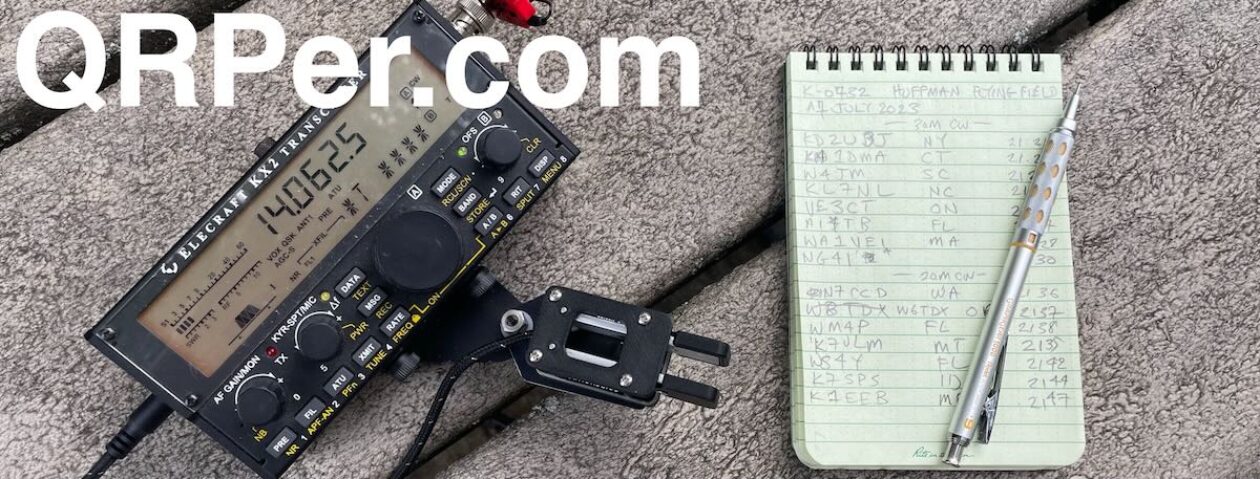 Many thanks to Michael (N7CCD) who writes:
Many thanks to Michael (N7CCD) who writes:
Hi Thomas!
I just watched your last activation video (very fun by the way!) using the TR-35 and thought I’d share really quickly my solution to the lack of an SWR indicator.
It was a cheap (and fun) $5 for the kit, build project I did with my brother, N7BHP, while visiting him in Mexico. It was actually the first little precursor project to building the TR-35 while on that same trip.
We picked up three (one for me and two for my brother) Pacific Antenna Mini SWR Indicator kits, and some cheap cases off of Amazon that just fit the meter. Of course, we had to add the BNC connectors also.
The kit is a 50ohm dummy load, and the LED lights up if the SWR is above 2:1. I’ve actually used this to tune my AlexLoop with the TR-35. When the light goes out, you’ve hit 1:1. I’ve found the LED on this kit to be more sensitive than the AlexTune light on the antenna.
I modified my kit to eliminate the switch. The way they have you build it is to leave it inline with your antenna, and just flip the switch from ‘forward’ to ‘reverse’. To save space and fit into the little plastic case, we jumpered where the switch would be so it stays in the ‘engaged’ position. I then just put it in at the very beginning of my setup to ensure the SWR is good on my antenna, then take it out of the circuit completely when using the radio.
It’s small enough to just live with my TR-35 at all times.
Hope all is well!
Michael -N7CCD
I love this, Michael. I think I might have to build one as well. Looks like a fun, inexpensive build that’s actually quite practical! Thank you for sharing!



I’ve built stuff from Pacific Antenna before and had good results. Thanks for the heads up on the SWR indicator, it will accompany my Venus-itech SW-3B on all road trips.
72 de KE2YK
Michael,
I would like to know where you bought the case for your TR-35. It looks like a padded hard shell case and perfect size for the rig.
Jerry/k5sop
Hi Jerry,
I found it on Amazon. It fits everything needed but the antenna. Here’s the link (hopefully it works…).
WERJIA Hard Carrying Case Compatible with MAYLUCK/AZZUTORK/APOWUS Handheld Nebuliser Portable Nebulisers(Case Only) https://a.co/d/hQXJ43F
Thanks Michael. I looked it up and also found a similar case but a little longer length. It is by Mosiso and may be enough to hold an antenna with the rig.
Nice. It would be cool to build this PCB into a small tabletop antenna, I might give that a shot!
Nice, I just ordered one for my TR-35 and what storage case is that, it looks to fit the TR-35 well! Cheers es 72/73, Davey – KU9L
Hi David,
It does fit it well! The TR-35 case was also amazon. We’ll see if the link works…
WERJIA Hard Carrying Case Compatible with MAYLUCK/AZZUTORK/APOWUS Handheld Nebuliser Portable Nebulisers(Case Only) https://a.co/d/hQXJ43F
Michael…
Small, simple & cheap. And perfect for QRP operations.
I like your Kit… and the build. Great report!
de W7UDT (dit dit)
I built one of these. Very clean and simple design that works well. I actually built it right into a short-ish patch cable that I already used, so I didn’t need connectors.
It’s great extra insurance since most little QRP rigs don’t have very good SWR protection.
I’ve built several Pacific Antenna kits; they’re good value. One thing about LED tuning indicators: they usually work best when pointed right at your eyes, rather that up at the sky. (Unless you’re already looking straight down at them, of course.) If you look from an oblique angle, you can tune them till they’re “dark”, then get up, stare straight down at them, and key down, and they’re still lit in there. They’re directional that way.
For folks who regularly use their LED tuning indicators facing up, it would be worth doing this experiment to see if you’re really getting accurate feedback. (This comment is just for the good of the order; LED indicators are all over our portable equipment, and I was chagrined to find I’d been operating with imperfect matches for some time.)
Thanks for this great post; I’ve saved the URL to several “notes” files, and will almost certainly follow your example and build this.